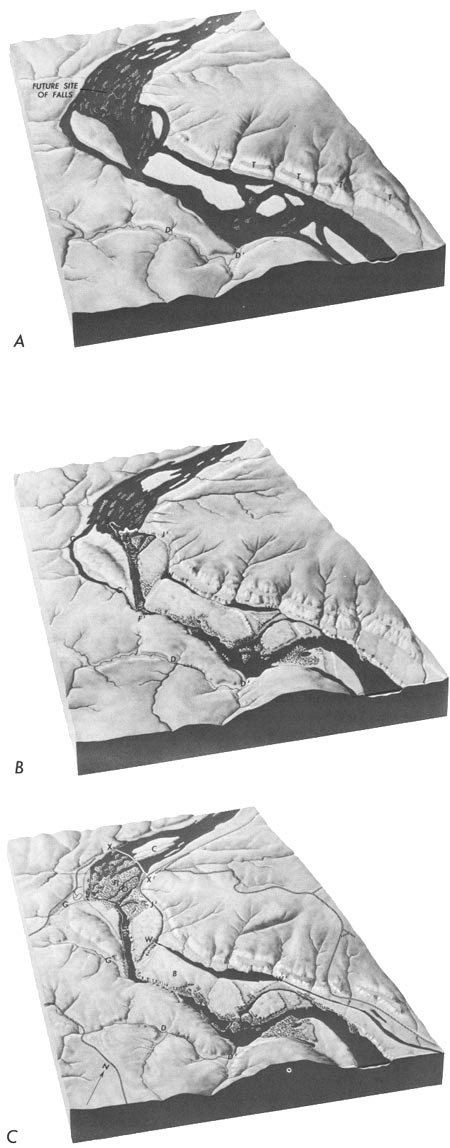
|
THE RIVER AND THE ROCKS
The Geologic Story of Great Falls and the Potomac River Gorge |
THE ORIGIN OF THE POTOMAC RIVER VALLEY AND THE CARVING OF GREAT FALLS

The carving of the falls continues
As the sea finally withdrew from the Atlantic Coastal Plain in the Washington area between 10 and 20 million years ago, streams draining eastward from the Appalachian Highlands spread a blanket of sand and gravel over the newly exposed sea floor and nearby parts of the Piedmont Plateau. This deposit was not laid down by a single major river, but by numerous streams that constantly shifted their courses back and forth to form a complex series of fan-shaped deposits that coalesced into the blanket of sand and gravel. Remnants of this blanket are still preserved capping some of the highest hills in the Piedmont near Tysons Corner, Va., 5 miles south of Great Falls. The deposit is a source of sand and gravel used for construction purposes in the metropolitan area.
Continued slow uplift of the Piedmont Plateau and the Appalachian Highlands to the west increased the slope of the land surface, causing the streams to deepen their valleys and eventually to coalesce into a river which was to become the Potomac. As this river deepened its valley, scattered remnants of its former flood plains were left at various levels as gravel-covered terraces. About 2 million years ago the river had succeeded in carving a broad, open valley in approximately its present position.
With the beginning of continental glaciation in the Pleistocene Epoch—about 2 to 3 million years ago—sea level was lowered, and the Potomac River began deepening this early valley. As water was withdrawn from the oceans to form the great ice sheets on the land, sea level around the world fell by as much as 500 feet. Most of the continental shelf off the eastern United States was exposed, and the shoreline lay as much as 75 miles east of its present position. Actually, continental glaciation occurred not just once, but at least four times in the last 2 to 3 million years. The last glacial episode ended only about 15 thousand years ago.
As sea level fell, the river cut correspondingly deeper into the floor of its former valley. The valley was rapidly deepened in the soft, easily eroded materials in the Coastal Plain, but in the hard rocks of the Piedmont Plateau the down-cutting was much slower. It was this downcutting into the hard bedrock floor of the older wider valley that produced the spectacular rocky gorge of the Potomac between Little Falls and Great Falls. At Great Falls the river encounters a series of thick layers of metamorphosed sandstone that are particularly resistant to erosion, and these hard ledges have slowed the progress of valley cutting. The river valley above Great Falls thus remains essentially the unmodified, original pre-Pleistocene valley, but below the falls the river flows in a gorge excavated within the last 2 million years. Along the gorge the original valley floor can be recognized as a flat gravel-covered bench 50 to 60 feet above the present river level. MacArthur Boulevard follows this bench from Cabin John to Anglers Inn. Some of the details of the cutting of the gorge and the sculpturing of Great Falls are illustrated in the block diagrams.
| <<< Previous | <<< Contents >>> | Next >>> |
bul/1471/sec4.htm
Last Updated: 01-Mar-2005
